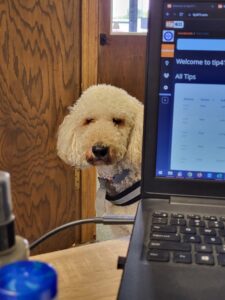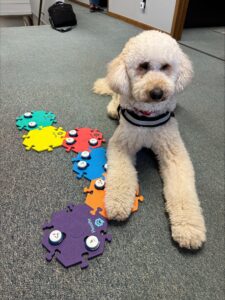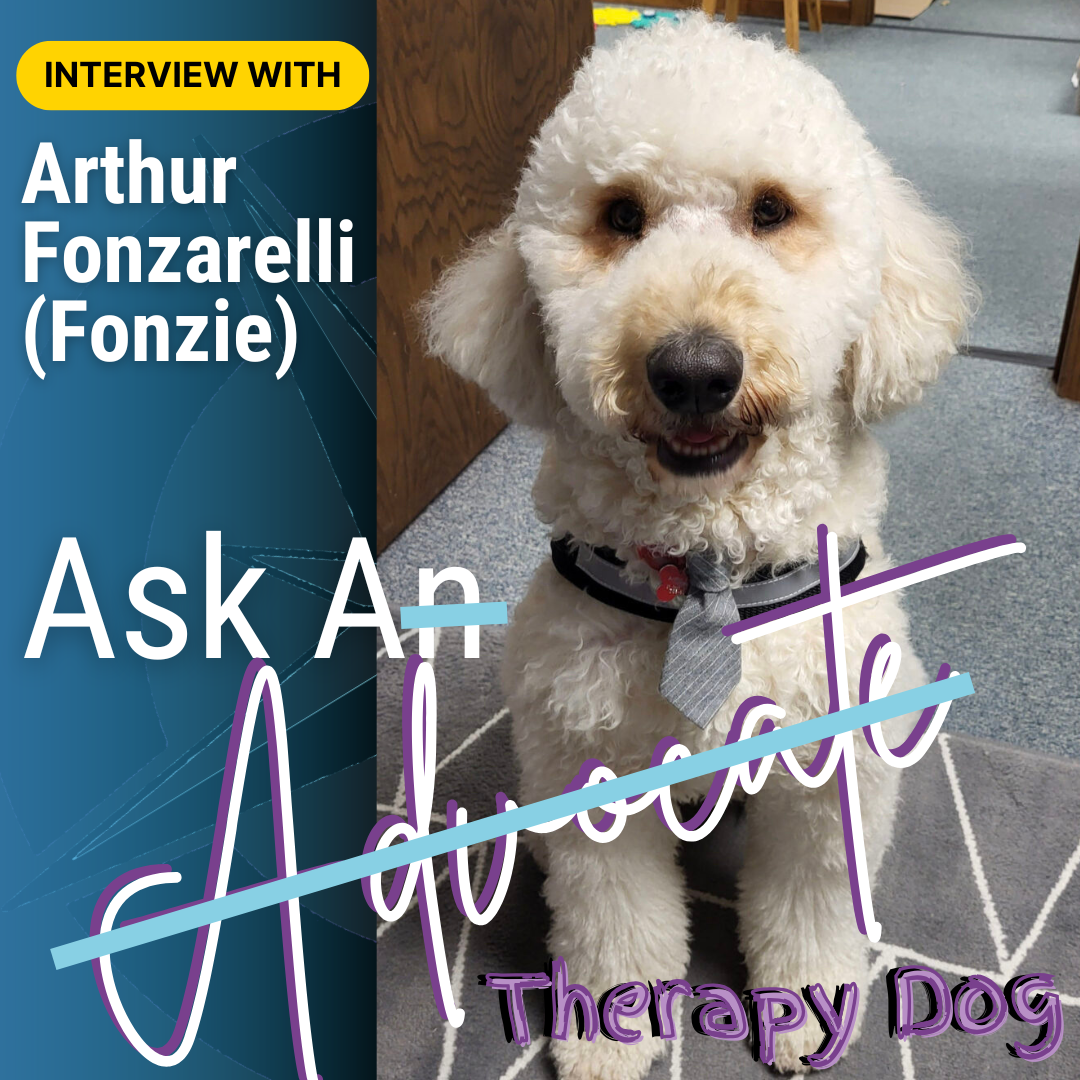We’re excited to introduce a truly unique member of our Options team for this ‘Ask An Advocate’ series—Arthur Fonzarelli, aka ‘Fonzie,’ our Therapy Dog.
Since joining us in November 2019, Fonzie has been a constant source of comfort, support, and love for everyone he meets. With a serious commitment to helping clients feel safe, he knows just when to bring out his calm, friendly side and when to roll over for a smile. Let’s hear from Fonzie himself as he shares his journey as a four-legged advocate.
Can you describe your primary responsibilities as an advocate?
“Absolutely! One of my titles is “Certified Good Boy and Resident Snuggle Expert,” but I am also known as the Therapy Dog. My job is to make people feel at ease, so they can open up and focus on healing. I know when a quick nuzzle or a gentle paw is just what someone needs, and if that fails, I just go for the ultimate move: belly up! It’s hard work, but I’m paws-itively committed to it.
 What is unique about your role?
What is unique about your role?
“Well, I’m the only one here with four paws and a tail, and that gives me a leg up (or four!) in the comfort department. I have this sixth sense for when people are having a ruff day, and I don’t even need words to help. All it takes is one look at my puppy-dog eyes, and I’m in—the magic of dog-ness at its best!”
How long have you worked for Options?
“I’ve been on the job since November 2019, which in dog years makes me practically a seasoned veteran! A little over five human years of tail wags, paw shakes, and comforting moments. But in dog years, I’m looking at 35 years of service, which means I’ve got the most seniority out of everyone! 😉”
What do you believe is the most important aspect of your job as an advocate?
“The most important part is making sure people feel safe, supported, and loved. Sometimes, people need someone who won’t judge, who’ll sit quietly beside them and let them pet my fur until they’re ready to talk. I take my work seriously because sometimes, a wagging tail is worth a thousand words.”
What are some of the key challenges you face in your role, and how do you address them?
“Squirrels. So many squirrels outside the windows. But I’ve learned to keep my focus—it’s all about the humans who need me. When I sense someone needs my comfort, I’m 100% there, even if my little doggy brain is doing backflips over a squirrel sighting.
That, and a lack of treats. I really should be getting more of those.”
 Can you share a memorable success story (while maintaining confidentiality) that highlights the impact of the work you do?
Can you share a memorable success story (while maintaining confidentiality) that highlights the impact of the work you do?
“One day, I sat next to a client who hadn’t said a word to anyone for a while. They started petting me, and little by little, they began to open up. By the end of the session, they were talking with the advocate. I may not be able to speak human, but I knew my presence helped make that possible. It’s why I do what I do.”
How do you practice self-care and prevent burnout, given the emotional intensity of the work?
“Lots of naps. Lots of pets from Ross. I may beg for a treat or two.”
How does your position work with other community resources or organizations to support survivors?
“I’m the ultimate conversation starter. When Options partners with community organizations, I’m there, reminding people that Options is a place of comfort and support. I break the ice and get people talking—even if I can’t understand all the words, I’m the master of “being there.”
 In your opinion, what are the most pressing issues facing survivors of domestic and sexual violence today?
In your opinion, what are the most pressing issues facing survivors of domestic and sexual violence today?
“It’s the fear and the difficulty of trusting again. People need to feel safe before they can start to heal, and I’m here to offer that quiet, judgment-free space. Just being with someone can help them remember that kindness and support still exist.”
How do you measure success? What does a successful day or client case look like to you?
“A successful day is when I’ve made someone smile, helped them relax, or just given them a moment of peace. If I leave Options at the end of the day with a tired wagging tail and the sense that I helped, then that’s success.”
What advice would you give to someone who wants to pursue a career in advocacy work for domestic and sexual violence?
“Patience, kindness, and lots of treats for yourself. This work isn’t easy, but knowing you’re helping people find safety and healing makes it all worth it.”
What do you wish people understood about your role? Or about working as an advocate in general?
“That I’m not just here to look cute—I’m here to help. My work may seem simple, but every nuzzle and every tail wag has a purpose: to make people feel comforted, safe, and loved.”
 How has working at the agency impacted your personal views or perspectives on domestic and sexual violence (or stalking, or human trafficking)?
How has working at the agency impacted your personal views or perspectives on domestic and sexual violence (or stalking, or human trafficking)?
“I’ve come to realize just how resilient people can be. I see the strength it takes for survivors to walk through our doors, and I’m constantly inspired by their courage.”
What keeps you motivated and passionate about your work, even when it becomes difficult?
“Knowing that my presence can make a difference in someone’s day, even if it’s just a small one. And, of course, the occasional treat and belly rub help keep me going!”
 Is there anything else you’d like to add?
Is there anything else you’d like to add?
“Just this—don’t underestimate the power of a well-timed belly rub or a comforting presence. We can all make a difference, one wag at a time. Woof!”
If you need any additional information, have a question, or a concern, feel free to reach out to Options at our 24-hour toll-free helpline 800-794-4624. You can also reach an advocate via text by texting HOPE to 847411 or click 24-Hour Chat with Options.
This grant project is supported by the State General Fund for Domestic Violence and Sexual Assault, sub-grant number 24-SGF-07, as administered by the Kansas Governor’s Grants Program. The opinions, findings, conclusions or recommendations expressed in this publication are those of the author(s) and do not necessarily reflect the views of the Office of Kansas Governor.


